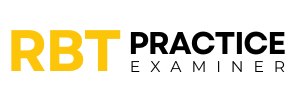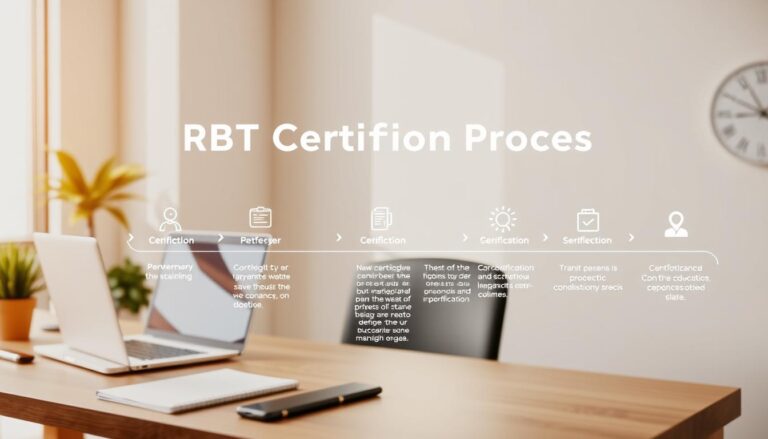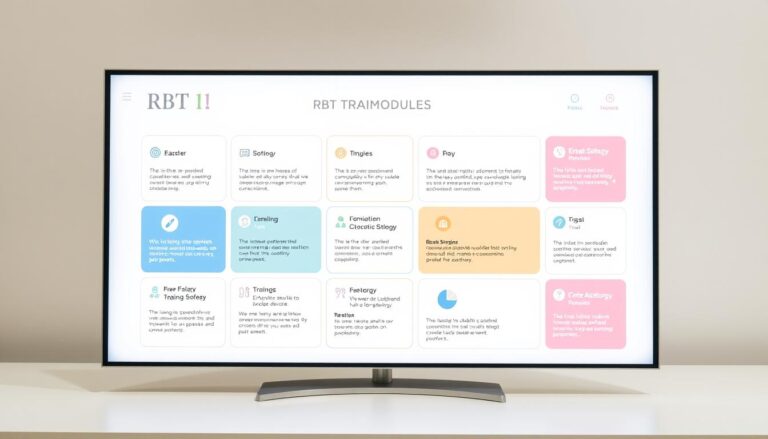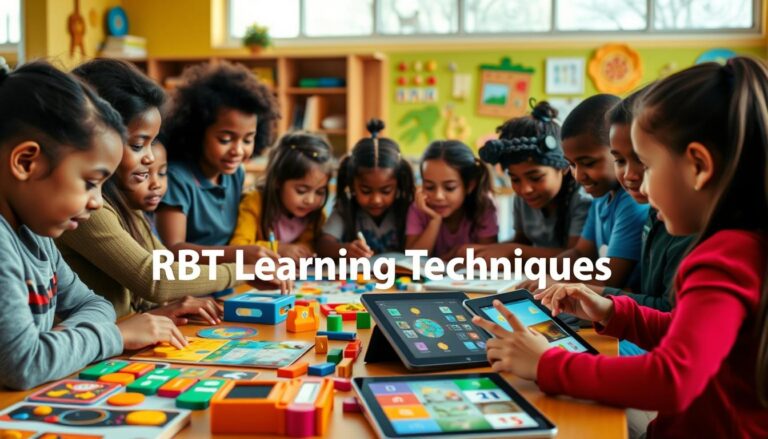The Meaning of RBT: What It Stands For
In the world of behavioral health, Registered Behavior Technician (RBT) is key. If you’re wondering what RBT means and its role in helping those with developmental challenges, you’re in the right spot.
An RBT is a special professional who helps implement behavior plans. They work with people with autism and other health issues, giving them vital support. This is done under the watchful eye of a professional.
Being an RBT is more than a job. It’s a promise to give top-notch, caring support to those who need it. Your journey to learn about this important healthcare role begins here.
Exploring the world of RBTs, you’ll find a career that mixes skills, emotional smarts, and a true desire to help. These experts learn to use specific techniques to greatly enhance their clients’ lives.
In schools and clinics, RBTs are changing lives. They team up with BCBAs to create and carry out plans that help people grow and be independent.
Ready to learn more about what RBT really is? This guide will cover everything you need to know about this fulfilling career. You’ll get the lowdown on training, duties, and the big impact RBTs have.
The RBT Role in Behavioral Health
A registered behavior technician is key in helping people with behavioral challenges, like those with autism. They work with Board Certified Behavior Analysts (BCBAs) to use important strategies. These strategies really help patients.
The RBT certification is for those serious about behavioral health. People looking for RBT jobs need to know how big this role is in healthcare.
Core Responsibilities of an RBT Professional
Registered behavior technicians do many important things. They help patients a lot. Their main jobs are:
- Implementing behavior intervention plans
- Collecting and documenting behavioral data
- Assisting with skill acquisition programs
- Supporting individual learning and development
- Maintaining professional communication with supervisors
Working Under BCBA Supervision
RBTs work with Board Certified Behavior Analysts. This team makes sure plans are right and followed well. Supervision includes:
- Regular performance reviews
- Ongoing training and skill development
- Collaborative treatment planning
- Quality assurance and feedback
Direct Patient Care Components
RBT work is very hands-on. It needs great people skills and patience. They create supportive places, use therapy, and help change behaviors for the better.
Successful registered behavior technicians mix technical skills with real care. They make a big difference in people’s lives.
What Does RBT Stand For: Breaking Down the Title
Understanding what RBT stands for is key for those interested in behavioral health careers. RBT is short for Registered Behavior Technician. It’s a special role in applied behavior analysis (ABA) therapy.
Let’s look at each part of the RBT title:
- Registered: This shows a formal certification process. It means professionals meet certain standards and qualifications in behavioral health.
- Behavior: It’s about analyzing and changing human behavior. This is for people with developmental challenges.
- Technician: It means a skilled person who uses behavior intervention strategies. They do this under the supervision of experts.
The registered behavior technician is vital in supporting people with autism, developmental disabilities, and behavioral challenges. They work directly with clients. They use behavior modification techniques designed by Board Certified Behavior Analysts (BCBAs).
What makes an RBT special includes:
- Specialized training in behavior intervention techniques
- Certification through a tough assessment process
- Commitment to ethical standards in behavioral health
- Direct patient care and support
To become a registered behavior technician, you need dedication to professional growth. You also need a real passion for helping people develop important life skills.
Essential Requirements for RBT Certification
To become a Registered Behavior Technician (RBT), you must meet certain requirements. These ensure you’re ready to help those with behavioral challenges. The journey to RBT certification requires focus on education and professional standards.
Those wanting to be RBTs must go through a detailed process. The rbt program has key steps that candidates must pass.
Educational Prerequisites
To get RBT certification, you need to meet basic education needs:
- Minimum age of 18 years
- High school diploma or equivalent
- English language proficiency
- No active felony convictions
Training Program Components
The training for RBT includes vital skills and knowledge:
- 40-hour training course with approved curriculum
- Supervised practical skill development
- Behavioral intervention techniques
- Ethical practice standards
Background Check and Eligibility
Candidates must pass a detailed background check for client safety. This includes:
| Screening Component | Details |
|---|---|
| Criminal Background Check | Comprehensive state and federal review |
| Professional Reference Verification | Validation of professional recommendations |
| Credential Verification | Confirmation of educational and training credentials |
Completing these steps shows a candidate’s dedication to excellence in behavioral health support.
The Path to Becoming a Registered Behavior Technician

Becoming a Registered Behavior Technician (RBT) is a journey that needs dedication and a plan. It’s about turning your love for behavioral health into a fulfilling career. You’ll go through important steps that help you grow professionally.
Your RBT training is the first step. You’ll learn about key techniques and ethics in behavioral interventions. This training is essential for your career.
- Research accredited RBT training programs
- Complete 40-hour initial training course
- Pass background screening requirements
- Schedule and prepare for RBT exam
The RBT exam is a big step in your journey. It tests your knowledge of applied behavior analysis and how to apply it in real situations.
To prepare for the RBT exam, focus on these:
- Use practice tests and study guides
- Review core competency materials
- Take part in supervised training sessions
- Learn behavioral techniques well
Those who pass show they can apply what they’ve learned. Your RBT program will include practical training and supervised experiences.
To keep your certification, you must keep learning and meet standards. Stay dedicated to your growth and professional excellence.
RBT Training Programs: Duration and Content
Registered Behavior Technician (RBT) training programs are designed to prepare professionals for the field of applied behavior analysis. They give aspiring technicians the skills and knowledge to help those with behavioral challenges.
The length of RBT programs varies from 4 to 6 weeks. This depends on the training provider and the learning format. Students can choose between in-person and online training, each with its own benefits.
Core Curriculum Elements
The core curriculum of RBT training covers important areas:
- Fundamental principles of applied behavior analysis
- Ethical considerations in behavioral intervention
- Data collection and documentation techniques
- Behavioral reduction strategies
- Communication protocols with supervisors and clients
Practical Skills Development
Hands-on training is key in RBT programs. Students practice in simulated scenarios and under supervision. They learn direct intervention techniques, safety protocols, and how to interact with clients.
Assessment Methods
Preparing for the RBT exam involves various assessments. Training programs usually include:
- Multiple-choice practice tests
- Skills demonstration assessments
- Supervised field observation evaluations
- Competency-based performance checks
Completing these assessments ensures candidates are ready for the official RBT certification exam.
Career Opportunities and Growth in RBT Field

The field of Registered Behavior Technicians (RBTs) is growing fast. It offers many job opportunities in healthcare and education. People in this field help those with behavioral challenges in many settings.
RBT jobs are becoming more common. They are needed in places like:
- Autism treatment centers
- Special education schools
- Private therapy clinics
- Home-based intervention programs
- Residential care facilities
Those interested in RBT jobs can expect good pay. Starting salaries are between $35,000 and $45,000 a year. As you gain more experience, your salary can increase a lot.
There are many ways for RBTs to advance in their careers:
- Pursue advanced certification as a Board Certified Assistant Behavior Analyst (BCaBA)
- Specialize in specific behavioral intervention techniques
- Transition into supervisory behavioral health roles
- Develop expertise in specific patient populations
The need for behavioral health workers is high. This means RBTs have great chances to build lasting careers. To succeed, keep learning, care deeply for your patients, and stay updated with the latest in your field.
RBT Salary Expectations and Benefits
Registered Behavior Technicians (RBTs) are vital in behavioral health. Knowing their salary is important for those thinking about this career. The salary for RBTs is promising for those who want to help people with behavioral challenges.
Starting salaries for RBTs depend on several things. New RBTs usually make between $30,000 and $45,000 a year. These jobs are a good start for those in the behavioral health field.
Factors Influencing RBT Compensation
- Geographic location
- Experience level
- Specialized skills
- Workplace setting
Geographic Salary Variations
Salaries vary a lot by location. Places with higher living costs often pay more. For example, RBTs in California or New York might make more than those in rural areas.
| Region | Average Annual Salary |
|---|---|
| West Coast | $42,000 – $52,000 |
| Midwest | $35,000 – $45,000 |
| Northeast | $40,000 – $50,000 |
Advanced Career Opportunities
RBTs can earn more by advancing in their careers. They can:
- Become a Board Certified Behavior Analyst (BCBA)
- Focus on specific behavioral areas
- Lead in behavioral health organizations
With experience, RBTs can make up to $65,000 a year. The demand for these professionals keeps growing.
Daily Responsibilities and Work Environment

A registered behavior technician is key in helping people with developmental issues. They work in many places, like clinics, schools, and homes. Each place offers different chances for growth and new experiences.
What does a registered behavior technician do every day? Here are some tasks:
- They follow plans made by Board Certified Behavior Analysts (BCBAs).
- They collect and write down detailed behavior data.
- They have one-on-one therapy sessions.
- They work with doctors and family members.
- They give direct support to people with autism and other developmental disorders.
RBTs need to be very patient, good at talking, and emotionally strong. It’s a tough job, but it’s also very rewarding. They get to make a real difference in people’s lives.
Their work environment is professional and always changing. They work with kids, teens, and adults, each needing their own approach. Staying calm, focused, and caring is essential for this job.
There are many RBT job opportunities in healthcare and education. People in this role build strong relationships and help others grow and change.
Professional Ethics and Guidelines for RBTs
Registered Behavior Technicians (RBTs) are key in behavioral health. They must follow strict ethical standards. The rbt certification process stresses the need for ethical behavior and integrity.
Ethical rules for RBTs protect clients and ensure quality care. These rules cover important areas:
- Client confidentiality and privacy protection
- Maintaining professional boundaries
- Commitment to evidence-based practices
- Ongoing professional development
Professionals must know the main ethical principles for their work. The Behavior Analyst Certification Board (BACB) has a detailed Ethics Code for RBTs. It outlines what RBTs should do and what they must avoid.
Important ethical points include:
- Respecting client autonomy and dignity
- Avoiding conflicts of interest
- Maintaining professional competence
- Reporting unethical behavior
RBTs must always put the client’s well-being first. They need regular supervision and training. This keeps their work ethical and of high quality.
Professional growth is essential for ethical practice. RBTs should:
- Participate in continuous learning
- Stay updated on best practices
- Seek guidance when facing ethical challenges
- Maintain transparent communication with supervisors
By following these guidelines, RBTs gain trust, keep clients safe, and help set high standards in behavioral health care.
Conclusion
Becoming a Registered Behavior Technician (RBT) is a great chance for those who want to help others. It takes a lot of training and hard work. But it’s worth it for those who care about making a difference.
As an RBT, you’ll find a field full of growth and joy. You’ll learn important skills to help people under the guidance of BCBA supervisors. This job shows you’re committed to helping others live better lives.
The role of RBTs is becoming more important in healthcare. They help people with autism and other developmental disorders. By getting trained and staying up-to-date, RBTs play a big part in helping people get better.
Being an RBT is more than just a job. It’s a chance to change lives and grow as a professional. It’s a career that needs dedication, compassion, and skill. It’s a chance to make a real difference in people’s lives.







